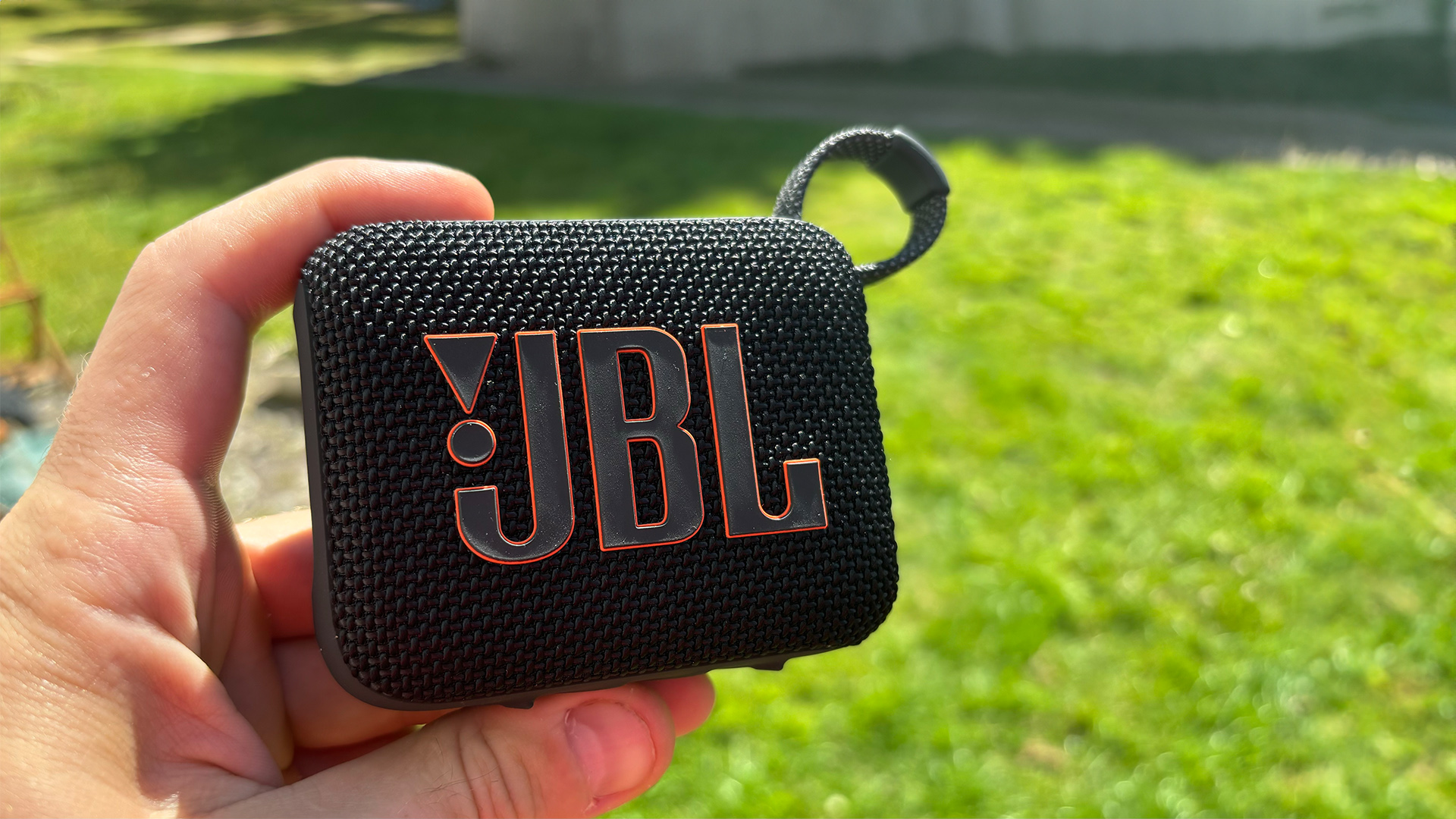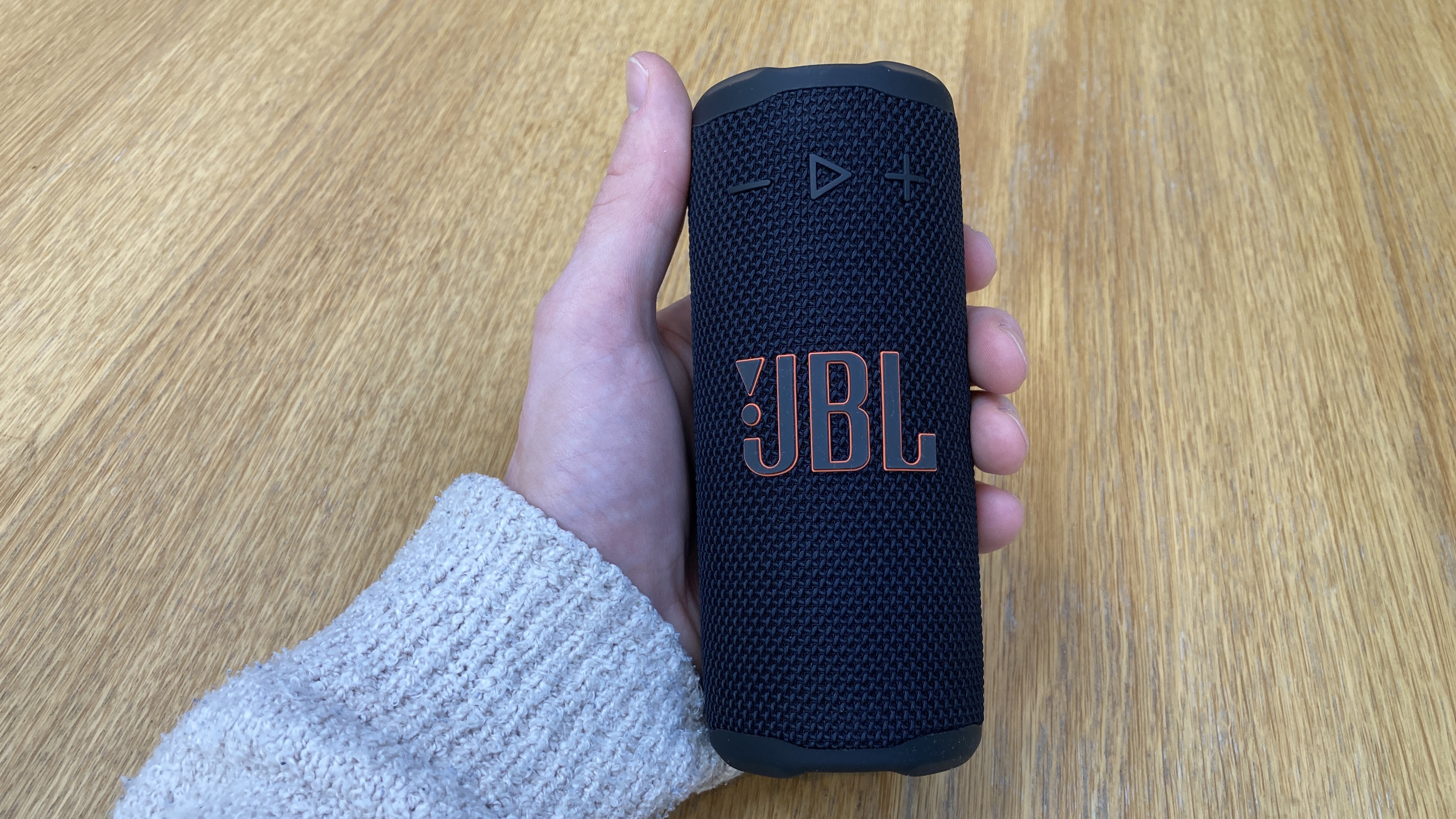What Hi-Fi? Verdict
The Go 4 fulfils its brief excellently, serving up a forward, cohesive sound in an affordable, impressively rugged little package
Pros
- +
Cohesive and engaging sound
- +
Solid feature set
- +
Adorably rugged, ultra-portable design
Cons
- -
Small size means an inevitable sonic limitation
- -
7-hour battery life may still be too limited for some
- -
Poor sound synchronisation of Auracast in stereo mode
Why you can trust What Hi-Fi?
Small, portable and super-affordable, we can completely understand the charms of JBL’s dinky line of Go Bluetooth speakers. For users who want to boost their listening experience on the move without handing over too many notes, a palm-sized unit with more muscle and refinement than the tinny little speakers your smartphone packs has serious appeal. Rugged ramblers, savvy students, heroic hikers, gardening groovers; the list of potential users, and usage scenarios, is near endless.
Price
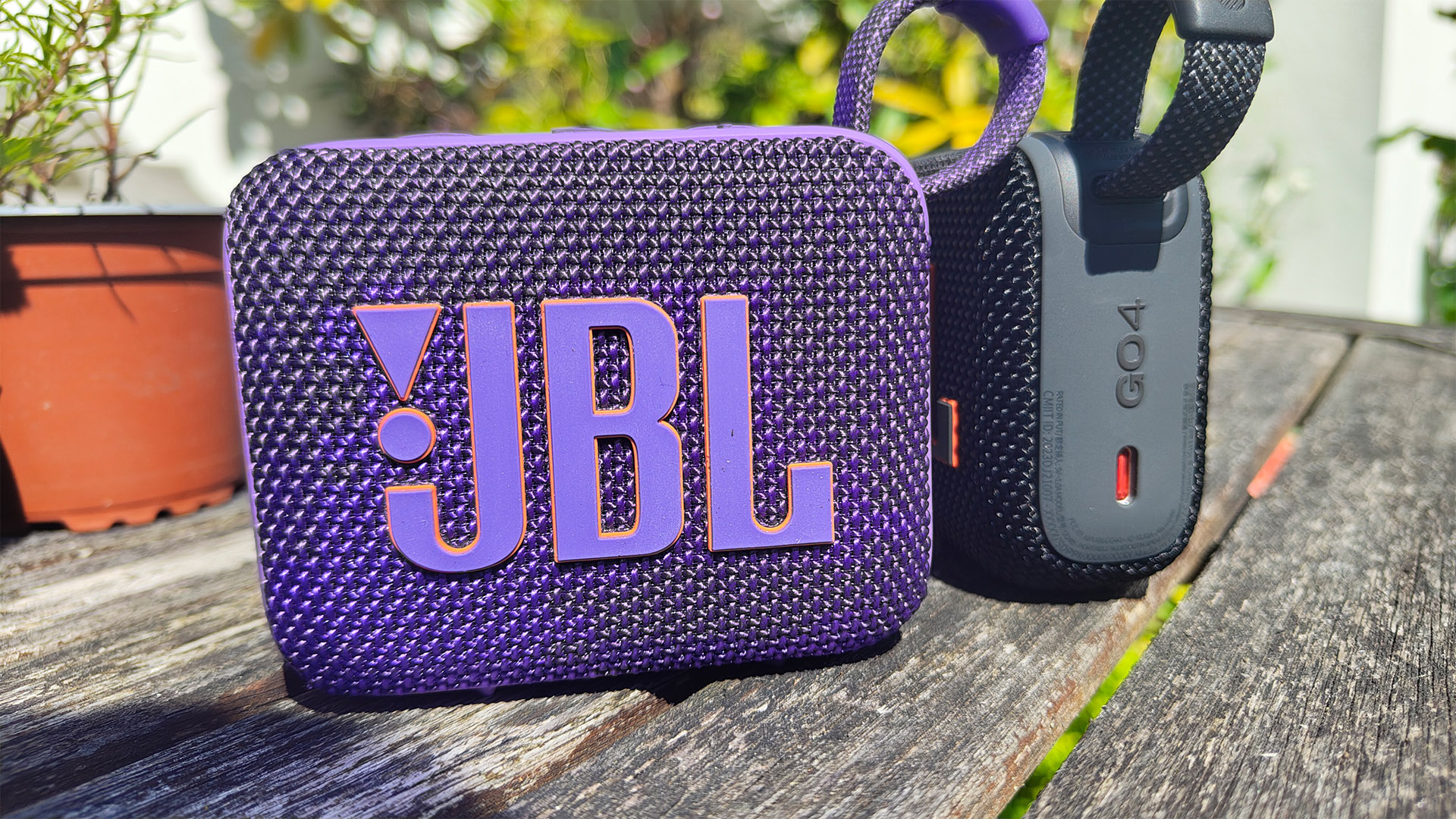
Being small and simple, the JBL Go 4 is not a bank-breaking portable speaker. Officially priced at £40 / $50 / AU$59, we’re right at the bottom of the price pyramid for what we’d term ‘proper’ Bluetooth speakers, so if you want something cheaper, you’re probably going to be looking at older models or products from miscellaneous brands on Amazon, Temu and the like. That said, we’re already seeing minor discounts, so don’t be surprised if you glimpse the new Go 4 at around £35 / $45 / AU$50 from time to time.
There are a few rivals and contemporaries knocking around at what is very much the entry point for decent portable sound. The five-star Tribit Stormbox Micro 2 usually sits at around £50 / $56 / AU$88, while frequent discounts often take the very likeable Ultimate Ears Wonderboom 3 down to around £69 / $80 / AU$120.
Build

“It’s so cute!” is the general descriptive consensus and covers most of what you need to know about the palm-sized JBL Go 4. But this being What Hi-Fi?, we obviously have to go into slightly greater depth than that. It is cute though, sporting the same form and dimensions as, say, a very chunky deck of cards or a standard bar of soap.
Being cute often goes hand in hand with being small. At around 70mm high, the Go 4 is a little taller than its predecessor, the JBL Go 3, but it’s a marginal gain that hardly turns the fourth-gen unit into some sort of pocket behemoth. It’s still a mega-portable design that’s made to fit in the hand, with an attractive, high-quality fabric finish that blends cool and classy with funky and fresh.
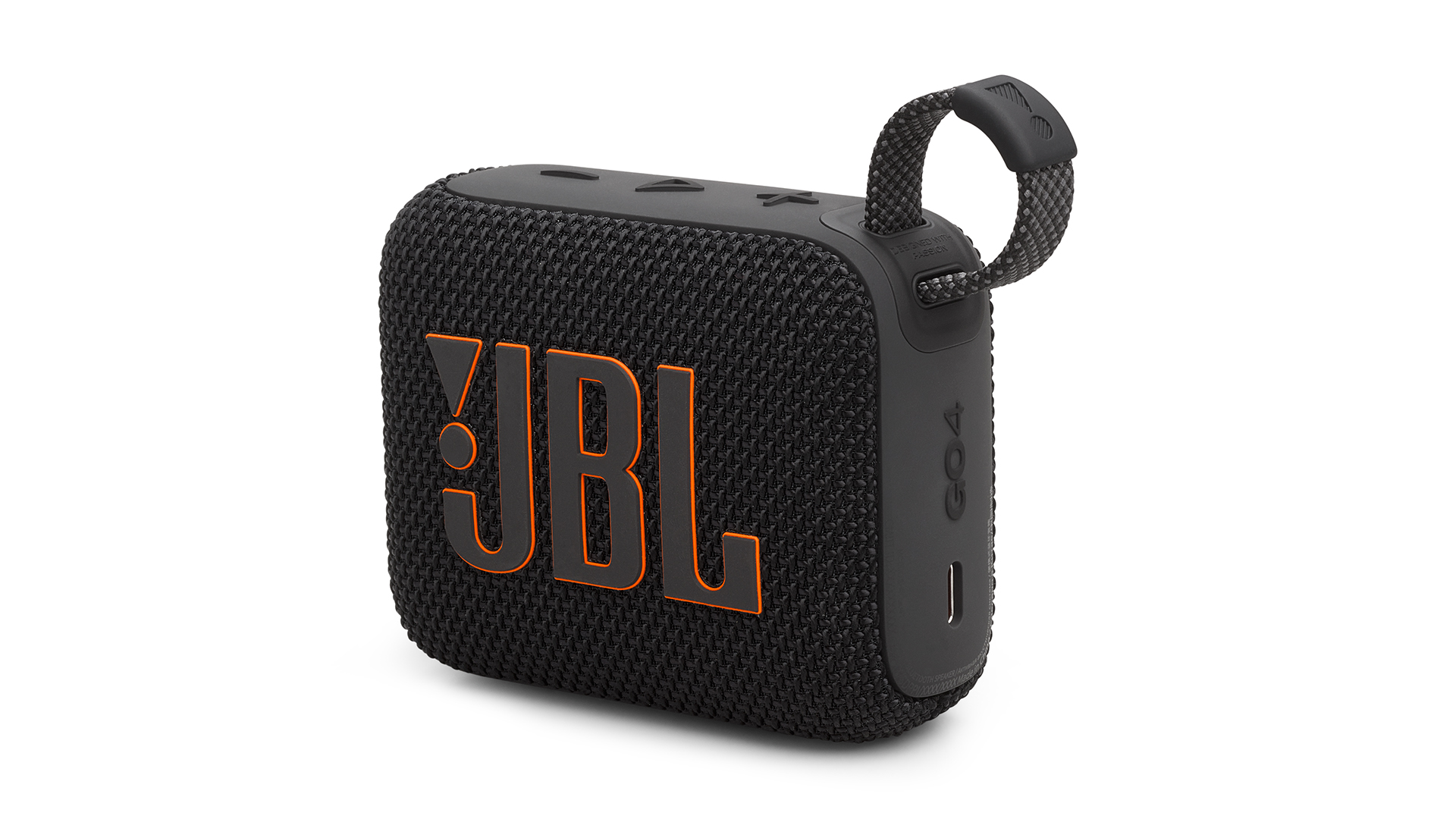
Power 4.2 watts
Bluetooth? Yes (5.3)
Mains-powered or battery-powered Battery-powered
Battery life Up to 7 hours (+2 with Playtime Boost)
Features Auracast compatible, Playtime Boost, IP67 rating, Bluetooth Multipoint
Connections USB-C (charging)
Dimensions (hwd) 7 x 9.4 x 4.2cm
Weight 190g
Finishes x 7 (purple, pink, red, black, white, blue, camo)
There are some key differences between the Go 4 and the older Go 3. The rubberised edging has been expanded outward so that it pretty much circumvents the entire unit, including at the top of the speaker where the larger play/pause and volume controls are housed. At the bottom are JBL’s signature diagonally-slanted ridges that offer more grip and stability when the Go 4 is placed upright, while further controls for Bluetooth pairing, power and Auracast adorn the speaker’s left side. There’s a small LED that will flash red when your power is running low, although we’d prefer a more precise, graduated system to show exactly how much juice you’re working with at any given time.
You’re also treated to a small fabric loop that sits at the top right corner of the Go 4, a handy adornment that feels as robust and durable as the rest of the main ensemble. It’s hard to resist the urge to either hook our little test sample over practically anything the loop will accommodate or else spin it around on one of our fingers, but never did we sense that there would be a point of weakness where the loop meets the main speaker body. Hardiness and durability remain the watchwords here.
The latest hi-fi, home cinema and tech news, reviews, buying advice and deals, direct to your inbox.
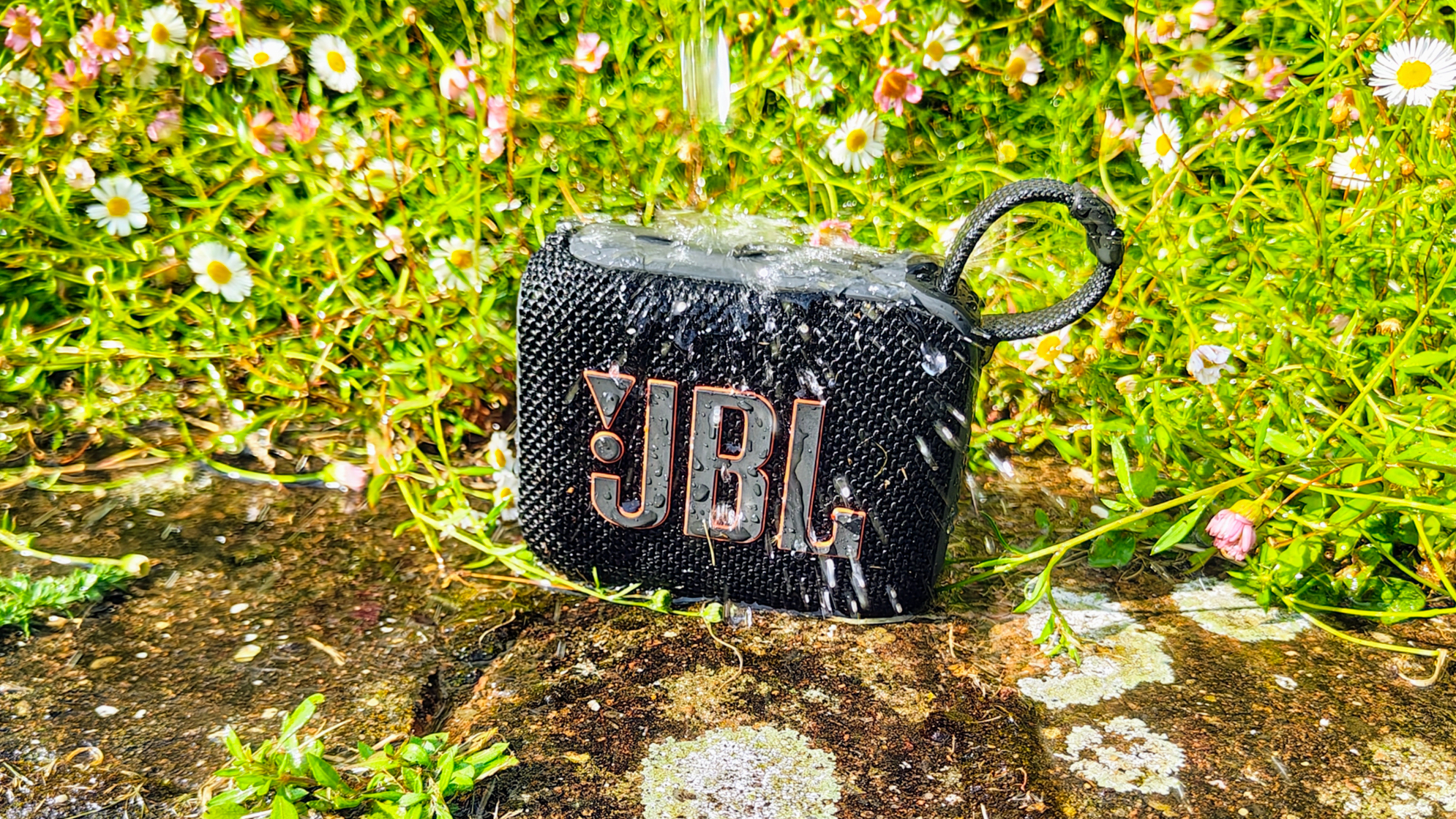
More than its predecessors, the Go 4 seems as though it’s been built to withstand the elements. Compared with those older units, this fourth-generation model seems far more action-ready, mainly thanks to its extra rubber adornments and slightly increased size. From what we can tell, such alterations have paid off – splashes from water and rain, not to mention some pretty rough treatment across gardens, fields and poolsides – have left little to no lasting impression on our hardy test unit. Dropped off a table onto a concrete floor? No problem. Sprayed with a garden hose? Easy. Slung in a backpack on the daily commute? You’d never know it from looking at our perfectly intact test model.
Features
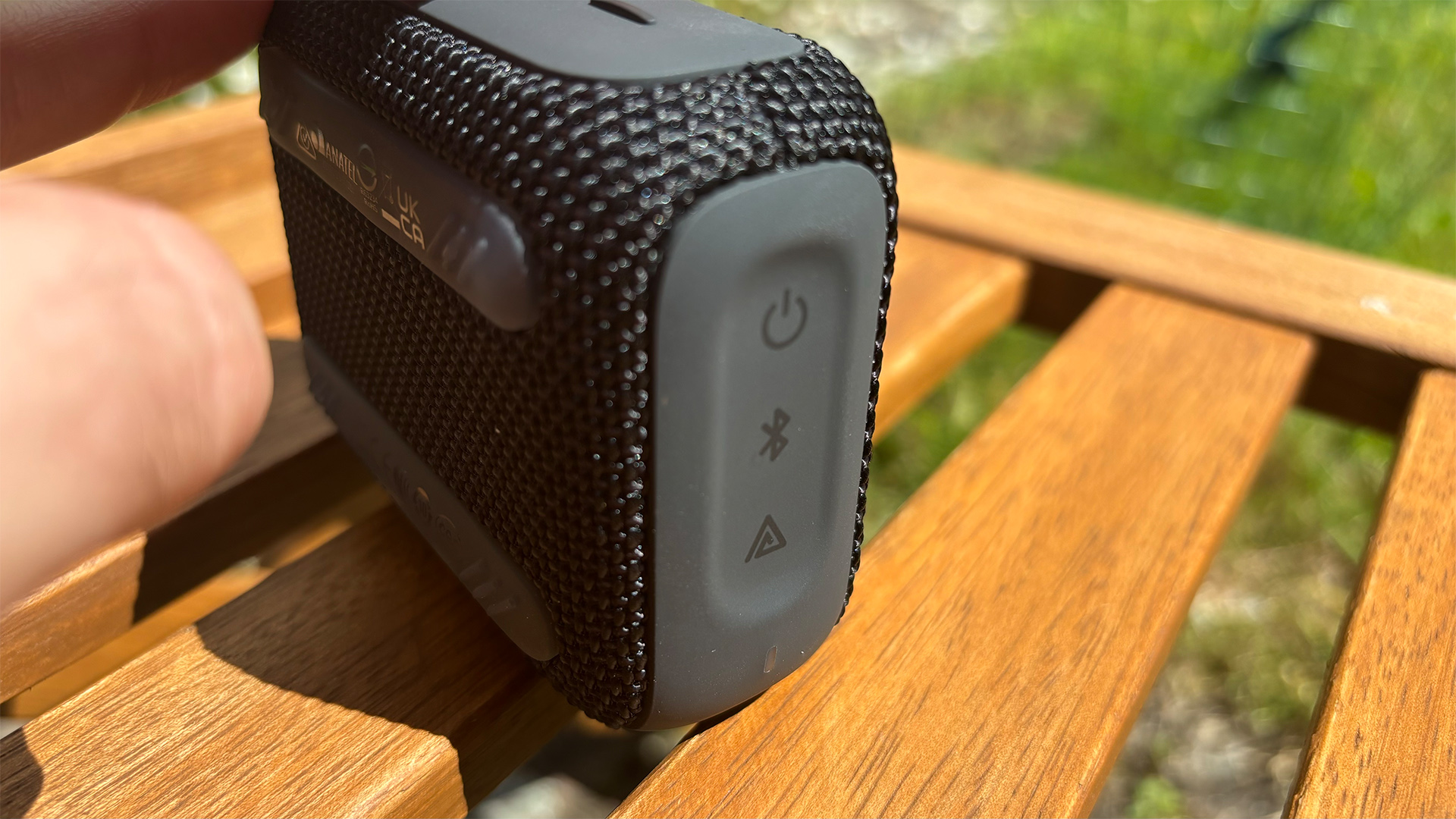
For the price paid, we’re not expecting an absolute avalanche of features from the Go 4. Some decent assets to aid usability, reliability and interconnectivity are enough to keep us happy, and thanks to the Go 4’s solid showing in these rather broad departments, it’s hard to be disappointed.
The big news is the introduction of Auracast Bluetooth compatibility, the same tech that we saw recently with the five-star, and much larger, JBL Xtreme 4 Bluetooth speaker. Replacing the PartyBoost functionality that has been a part of many of JBL’s most dependable models, Auracast essentially lets you pair two Go 4 speakers together in stereo or hook up multiple compatible JBL units, either via an on-unit button or through the provided JBL app. It also gives the Go a degree of future-proofing, as newer JBLs with Auracast will likely be compatible with the current model.
Stereo pairing is easy to set up and use with our two review samples, but we just wish that there was better sound synchronisation between the two units – often we detect a noticeable delay from one speaker to the other when music is being played in stereo mode.
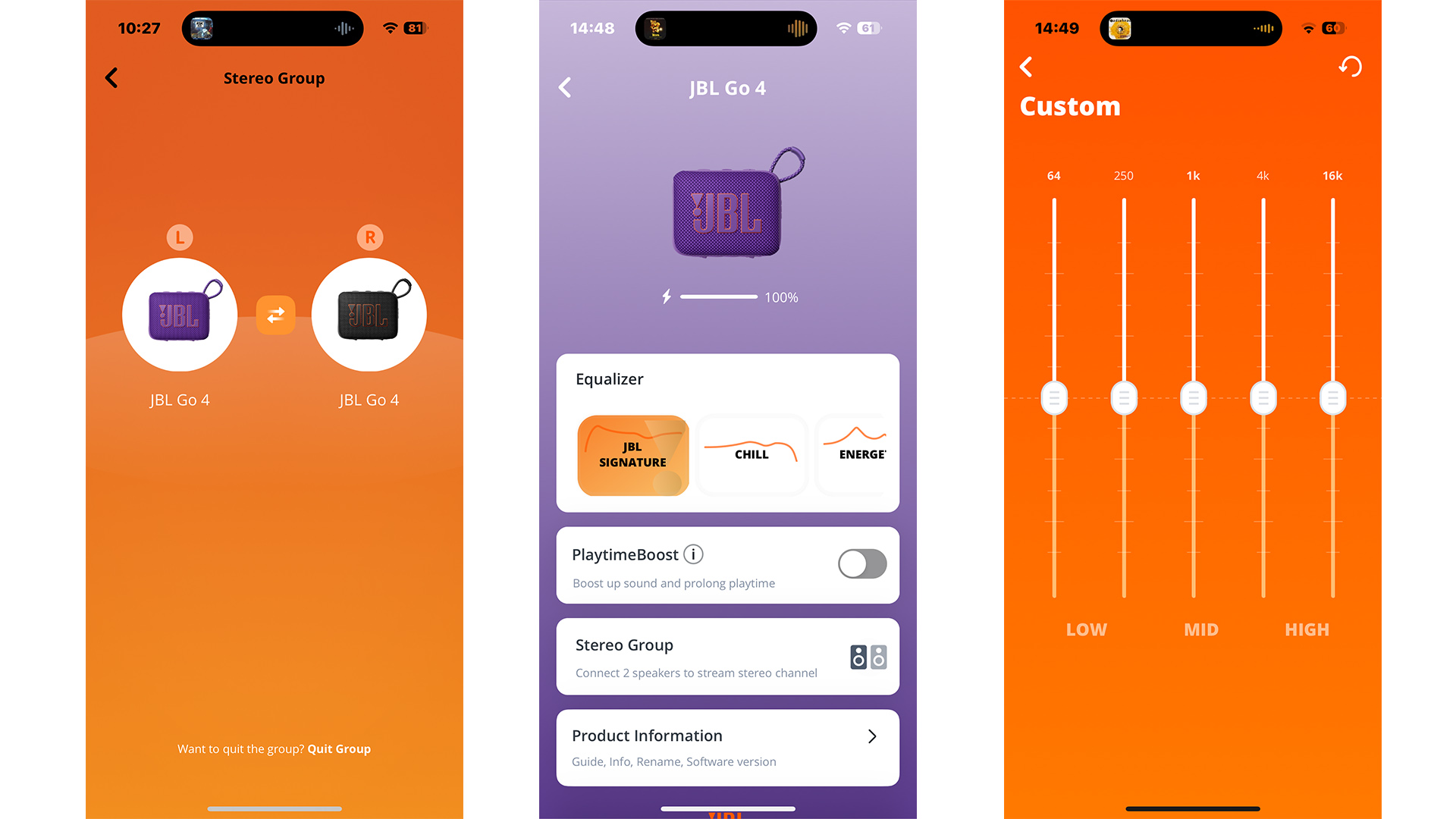
Setting up and managing Auracast is done predominantly via the JBL Portable app, a platform we both admire and enjoy using – it’s well laid out, comprehensive and simple to navigate. Auracast aside, it’s also the place from which you’ll be able to access a handy five-band custom equaliser, check your speaker’s battery life and toggle a relatively new feature from JBL, Playtime Boost.
Playtime Boost, as the name suggests, is a canny tool which aims to squeeze out around two extra hours from the Go 4‘s battery, and while that’s appealing for a speaker with comparably meagre numbers in this field, we’d still urge you only to use it in a real pinch. As we found when testing the Xtreme 4, Playtime Boost leads to an odd sonic imbalance, amping up high and mid tones but pulling the weight and authority out of the lower registers. For a speaker that isn’t exactly brimming with bass, it’s not an experience we’d recommend, if you have a choice.
Instead, you’re better off sticking with the standard battery life provided by the Go 4. The good news is that this generation’s battery has been improved (hooray!), up to a maximum of seven hours from the pretty paltry five hours offered by the third-gen Go. Charging time is improved, too, dropping from the three-and-a-half-hour figure of the Go 3 to a more acceptable three hours.
Sound
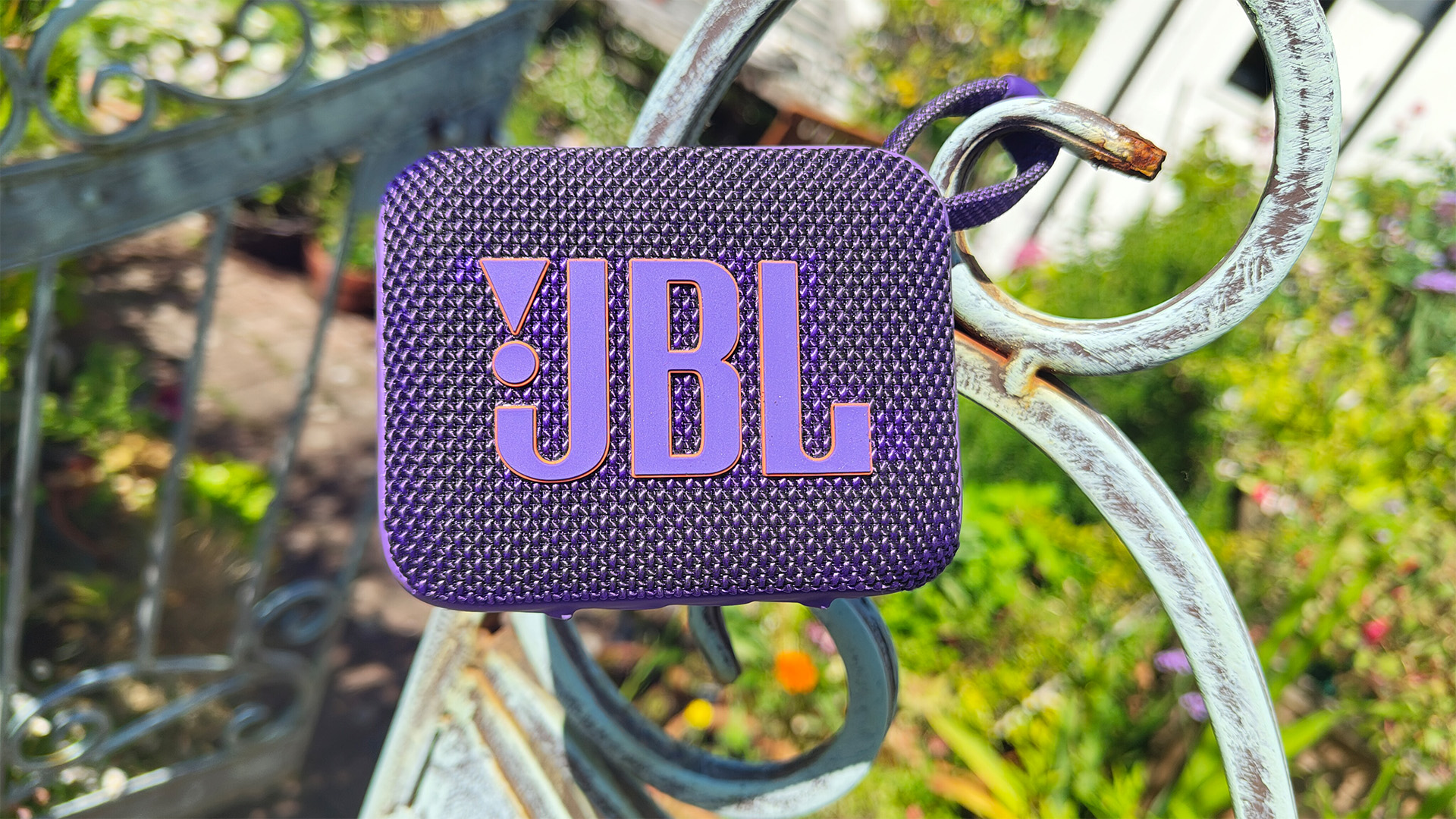
While it wasn’t the Go 3’s sonic capabilities that robbed it of the full five stars, we’re still expecting some improvements from one generation to the next. JBL has been working on getting the most out of its smallest line of portable units, this time adding a larger transducer – the Go 3’s was 43mm, the Go 4’s unit is now a bigger 45mm – as well as a new and more efficient amplifier for better audio and a louder sonic ceiling.
They’re small tweaks that have patently paid off. The third-gen Go was balanced, well-ordered and surprisingly robust in its sonic presentation, characteristics that have been passed down to the 2024 follow-up.
The textures within Temple Of The Dog’s Times Of Trouble, be they hard-edged guitars, light-footed drums or Chris Cornell’s signature throaty wail, are communicated with admirable clarity and character. Rather than merely giving us a rough outline of instruments or voices, the Go 4 wows us with its ability to fill in the gaps, providing a comprehensive mix of structure and body to the music it conveys.
From top to bottom, the Go 4 is impressive for such a small and inexpensive unit, and we’re enamoured with how the JBL keeps contrasting elements from feeling muddled or out of place. Taut, robust bass tones anchor the lower end, midrange textures come through without becoming lost, while the higher registers rarely come over as grating or overly keen. Such levels of organisation are striking for a dinky speaker that could well have sounded cluttered, muffled or slipshod in its delivery.
That tight lower end only aids the Go 4’s rhythmic abilities. JBL’s tiniest dancer doesn’t have two left feet, picking out the contrasting rhythmic patterns of Korn’s Freak On A Leash or Calvin Harris’ Feels and making them shine. There’s a sense of propulsion here, too – the Go 4 provides Gorillaz’ Aries with the surge and impetus it needs in order to feel snappy, front-footed and fun.
Even when we take the Go 4 out on a mini-adventure, it shines. Outdoor use is likely to be one of the pocket-sized portable’s primary purposes, and it seems as though JBL has done the hard yards in ensuring that the fourth-gen Go is as comfortable out on the town as it is having a night in.
We pop the speaker on a garden chair and load up Christopher Lennertz's’ I Can Do Anything, AKA Homelander’s Theme from The Boys, and we’re struck by how well the music is carried as we step further away from the source. Even at 15 or so paces, we can hear the scratchy, maniacal personality of those strings combining with the track’s terrifying horn blasts to create an appropriately intense concoction.
If we had to criticise this speaker, we would point out that it doesn’t have the open, more mature presentation of the immensely competent Tribit Stormbox Micro 2. The organisation abilities of the JBL are noteworthy considering its size and price, but the tangible sense of breadth and cohesion from the Tribit can make the smaller Go 4 sound a little narrow in its overall presentation.
The more expensive and only slightly larger Tribit is also better at making voices sound clear and natural, excelling through the midrange in a way that the JBL can’t quite match. None of that diminishes our love for the Go 4, but it’s worth noting if you were thinking of spending a little more and can consider the five-star Tribit.
Verdict
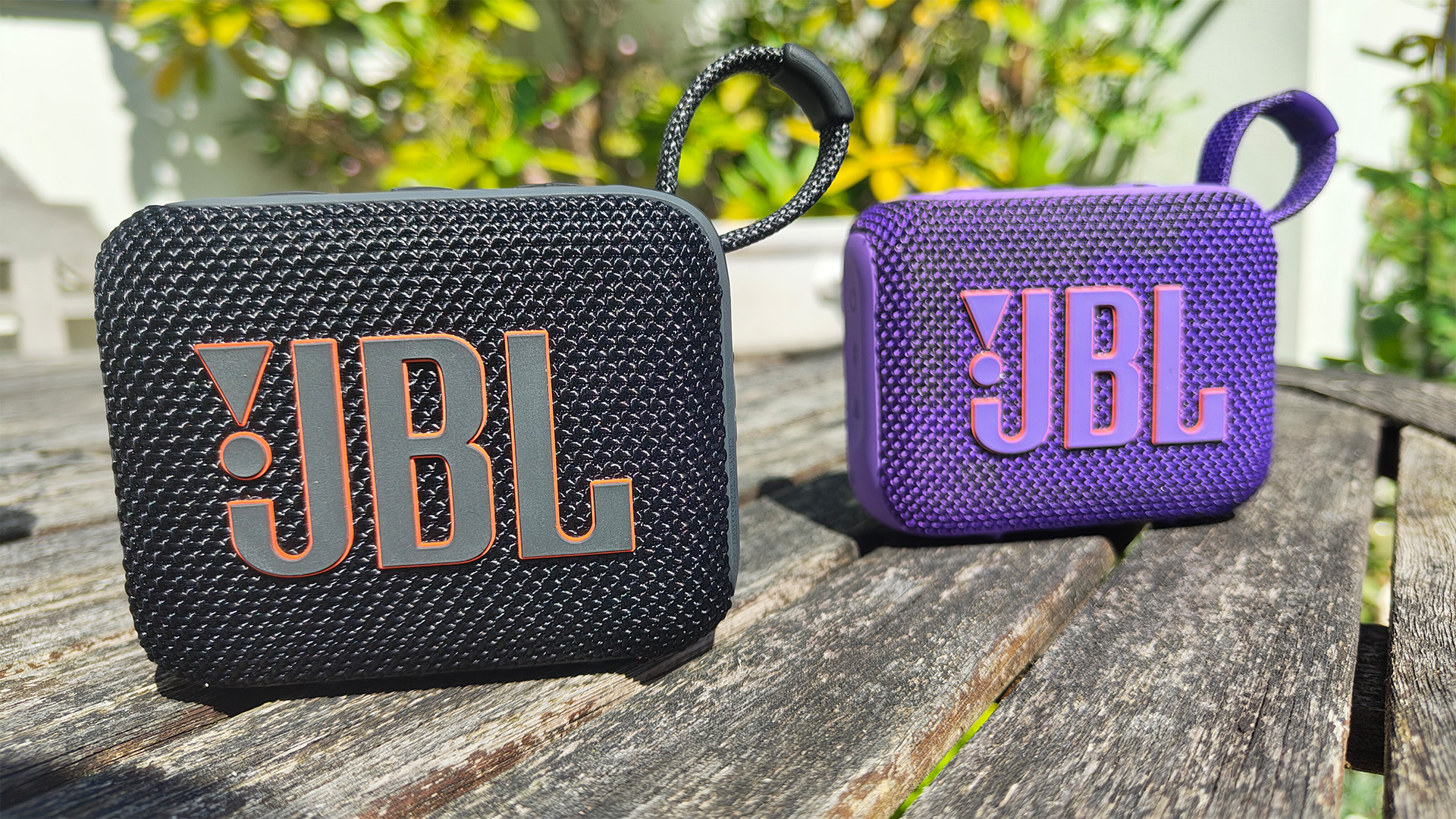
Judged on its own merits, the Go 4 feels like JBL nailing a winning recipe at this end of the market. Maybe we’d like even more battery life, but that’s not enough to soften our affections for the Go 4, thanks to its strong sonic capabilities, cute build and solid feature set, all of which combine to make it a brilliant budget buy.
Going up one level more will grant you more openness and refinement if you’re willing to spend a bit more cash, but for all-round performance at a shoestring price, the Go 4 is another win for JBL.
First reviewed: August 2024
SCORES
- Sound 5
- Build 5
- Features 5
MORE:
Read our review of the Tribit Stormbox Micro 2
Also consider the JBL Go 3
Read our Ultimate Ears Wonderboom 3
Best Bluetooth speakers tried and tested for every budget
Best Bluetooth speakers under $100: budget models tested by our experts
What Hi-Fi?, founded in 1976, is the world's leading independent guide to buying and owning hi-fi and home entertainment products. Our comprehensive tests help you buy the very best for your money, with our advice sections giving you step-by-step information on how to get even more from your music and movies. Everything is tested by our dedicated team of in-house reviewers in our custom-built test rooms in London, Reading and Bath. Our coveted five-star rating and Awards are recognised all over the world as the ultimate seal of approval, so you can buy with absolute confidence.
